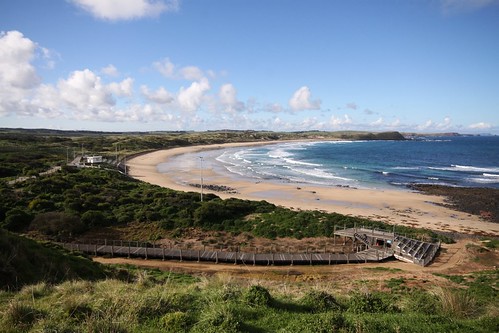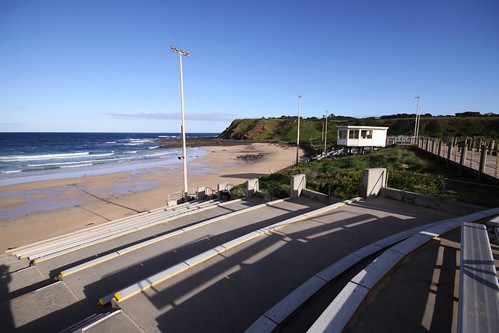If you have ever paid a visit to Victoria’s Phillip Island, the reason for the trip was probably the nightly Penguin Parade, where wild little penguins emerge from the sea at sunset and waddle across the beach to their sand dune burrows.
Located on the south-western tip of the island at Summerland Beach, the Penguin Parade is one of Australia’s most popular wildlife attractions, with almost half a million people visiting each year. To cater for these hoards of tourists, floodlights illuminate the beach in front of concrete viewing terraces, and a network of boardwalks have been constructed over the sand dunes so that the delicate environment beneath is protected.
While today’s Penguin Parade is a big budget production, this postcard from 1940 shows a very different scene at Summerland Beach. It was an age of little environmental concern, when parking cars on the delicate penguin burrows was not given a second thought, and introduced foxes and pet dogs killed dozens of penguins.

Photo from the Phillip Island and District Historical Society collection
The first organised trips to see the Summerland Beach penguins occurred in 1928, when local residents Bert West, Bern Denham and Bert Watchorn started to pick up visitors at the Cowes ferry pier and take them on a tour of the island for five shillings. However it was not until the 1940 opening of a bridge to the mainland that tourism to the island really took off, and so did the environment damage caused by the hoards of visitors.
The first efforts to protect the penguin colony date to 1930, when four hectares of land on the Summerland Peninsula was given to the people of Victoria by Mr and Mrs Spencer Jackson as a penguin reserve. Additional land was added to the reserve soon after by the Phillip Island Shire Council, with further land added in 1955, and formal regulations for the reserve being gazetted in 1956. Development of tourist infrastructure commenced in 1961 when fences and concrete viewing stands were erected along the beach, with the involvement of the National Parks and Wildlife Service.
Today management of the facilities is the responsibility of the Phillip Island Nature Parks, a not-for-profit body created by the State Government to conserve and protect the flora and fauna reserves of the island. The current facilities at Summerland Beach date to 1988 when a major redevelopment was carried out, with the opening of a visitor centre and carpark a few hundred metres away from the sand dunes, enlarged viewing terraces on the beach, and a network of boardwalks to link the two.
With the park receiving no recurrent operational funding from the government, Phillip Island Nature Parks is reliant on income from tourist operations to fund their activities. In 2007/08 the total operating revenue was almost $14 million, when a total of 487,251 people visited the penguin parade, with 63% of them being international tourists. With the competing interests of wildlife conservation and increasing the number of visitors, management needs to walk a fine line to avoid destroying the very reason for the park existing.
And an update
In 2016 it was announced that an upgraded visitors centre would be built at the Penguin Parade, at a cost of $48.2 million.
The new complex opening in July 2019.
Along with an upgraded ‘premium’ viewing area.
Sources
- History of the Penguin Parade from the ABC program ‘Penguin Island’
- History of the Summerland Peninsula by Roz Jessop, Environment Manager at the Phillip Island Nature Parks
- The potential impacts of climate change on the Phillip Island Little Penguin colony, a report from 2009
- Strategic Management Plan 2012–2017, Phillip Island Nature Parks
- Annual Report 2009/2010, Phillip Island Nature Parks






Nice work. I remember going there and just sitting on the sand as the penguins came up and went around me. In later years we would drive around the Summerland Estate looking for them when they crossed the roads. It is very slick now and the estate housing owners bought out.
Hi Andrew,
The history of the Summerland Estate is a rather interesting one: I’ve been planning to write about it for some time.
The estate was subdivided in the late 1920s onwards, with quite a handful of blocks being sold but only a handful of houses being built. By the 1950s it was realised that building on top of the penguin breeding area was a bad idea, but it took until 1985 for the government to start buying out the owners. The program didn’t finish until 2010, with the area now being revegetated.
I don’t know that any of the houses had decent ocean views and it was very windy there, especially when a southerly was blowing, so there wasn’t a lot of appeal to the area. I remember when the last house was bought out in 2010. I felt sad, but pleased too. Some of the local yoof used to do pretty nasty stuff to penguins on the roads with their cars but it was nice for decent people to slowly drive the streets and see a penguin or two. I didn’t realise the estate was so old. I look forward to hearing more.
Marcus, I will be interested in your history when you get round to it. Do you know much about the wonderful old house on the Bluff above the Summerland Beach? I went there a couple of time in the late fifties early sixtiesr and was lucky enough to camp in the paddocks behind the penguin dunes.
Would this be the place – “Penguin Beach Private Hotel”?
http://handle.slv.vic.gov.au/10381/67913
Hi Marcus – yes, this certainly is the old Summerland Guesthouse. I lived there for a short time with my family & a friend in the 1970s – the guesthouse was closed by then, but we knew the owner who allowed us to live in a couple of the cabins at the rear of the main building prior to our move to Tasmania. The building has disappeared, along with all the other buildings in the area, as you say, a bad idea to build on top of the penguin colonies.
marcus I have just found this page because I was looking for Summerlands Guest House.
are you writing a history??
my mother and her family lived and ran the guest house during the 1940’s..also had other connections with the island
my mother is still alive and very vivid with all her wonderful tales about life on the island at at Summerlands..if you would like to talk to her for your research, i am sure you could do that..whilst a first hand source is still available..
thx
April
[…] Phillip Island is also the home of ‘Summerland Estate’ – a topic I’ve touched on before. […]
[…] Subdivision of Summerlands commenced in the 1920s with 12 large allotments created, along with features such as a roundabout and cypress trees that were still visible decades later. Between 1927 and 1931, 227 new blocks were created, and from 1929 to 1940 there was a nine-hole golf course on what is now the Penguin Parade car park. […]
What is the temperature in February?
Mean maximum of 23.9°C and minimum of 14.1 –
http://www.bom.gov.au/climate/averages/tables/cw_086354.shtml
So not too bad for sitting out in the open waiting for the penguins to come in.